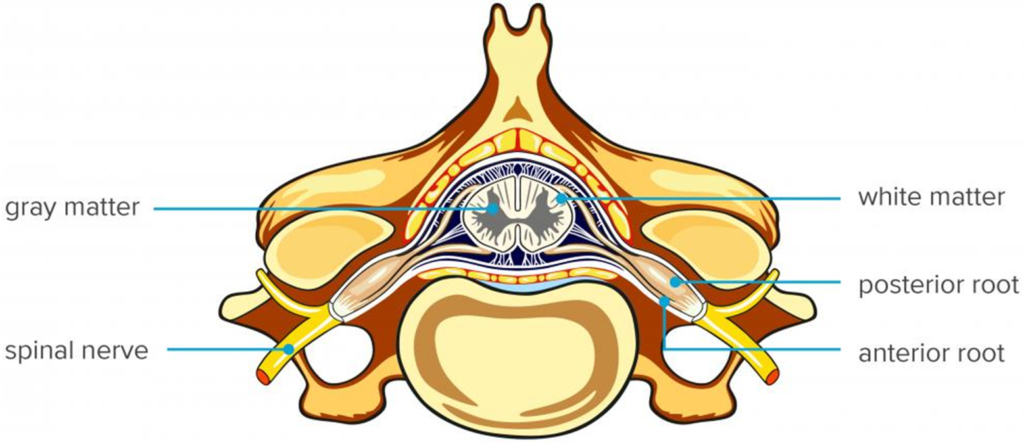Spinal Cord
The spinal cord is a cylindrical bundle of nerves that extends from the brainstem to the lumbar region of the vertebral column. It is encased within the vertebral canal formed by the vertebrae. The structure of the spinal cord can be divided into several regions:

1. Gray Matter: Gray Matter refers to the region of the central nervous system (CNS) that consists primarily of neuronal cell bodies, dendrites, unmyelinated axons, synapses, and glial cells. It is responsible for processing and integrating information, including sensory perception, muscle control, memory, and decision-making.
In the brain, gray matter is found in the cerebral cortex, basal ganglia, thalamus, and brainstem nuclei. In the spinal cord, it is located in the inner region, forming an “H”-shaped structure.
Unlike white matter, which contains myelinated axons for rapid signal transmission, gray matter mainly handles signal processing and neural communication.
2. White Matter: White matter is the part of the central nervous system (CNS) composed mainly of myelinated axons, which connect different regions of gray matter and facilitate rapid nerve signal transmission. The myelin sheath, a fatty substance covering the axons, gives white matter its characteristic white appearance and enhances the speed of electrical impulses. In the brain, white matter is found in the deeper layers, beneath the gray matter of the cerebral cortex. In the spinal cord, it is located in the outer regions, surrounding the gray matter.
3. Spinal Nerves: Spinal nerves are mixed nerves that emerge from the spinal cord and are responsible for transmitting sensory and motor signals between the CNS (central nervous system) and the rest of the body. Each spinal nerve serves a specific region of the body, forming a dermatome, which is a skin area supplied by a particular spinal nerve.
Functions of Afferent (Sensory) and Efferent (Motor) Nerve Tracts:
1. Afferent (Sensory) Nerve Tracts
Afferent nerve tracts, also known as sensory nerve tracts, are pathways within the nervous system that transmit sensory information from the peripheral sensory receptors to the central nervous system (CNS), including the brain and spinal cord. These tracts play a crucial role in conveying various types of sensory stimuli, such as touch, pain, temperature, proprioception (sense of body position), and vibration, allowing the CNS to perceive and respond to the external and internal environment.
Dorsal Columns (Ascending Sensory Pathways):
Function: Transmit fine touch, vibration, proprioception (sense of body position), and pressure sensations.
Major Tracts: Fasciculus gracilis and fasciculus cuneatus.
Spinothalamic Tracts (Anterolateral Pathways):
Function: Transmit pain, temperature, and crude touch sensations.
Major Tracts: Lateral spinothalamic tract and anterior spinothalamic tract.
2. Efferent (Motor) Nerve Tracts
Efferent nerve tracts, also known as motor nerve tracts, are pathways within the nervous system that transmit motor commands from the central nervous system (CNS) to the peripheral nervous system (PNS), including muscles and glands. These tracts play a crucial role in controlling voluntary and involuntary movements, as well as regulating autonomic functions and glandular secretion.
Corticospinal Tract (Pyramidal Tract):
Function: Controls voluntary movements of skeletal muscles.
Origin: Pyramidal cells in the primary motor cortex.
Decussation: Most fibers decussate (cross over) at the medulla.
Extrapyramidal Tracts:
Function: Regulate balance, posture, and involuntary muscle movements.
Examples: Rubrospinal tract, vestibulospinal tract.
Reflex Activity
1. Definition: An involuntary and nearly instantaneous movement or response to a stimulus.
2. Components of a Reflex Arc:
Receptor: Sensitive to a specific stimulus.
Sensory Neuron: Transmits the impulse to the spinal cord or brain.
Integration Center: Consists of one or more spinal cord or brain synapses.
Motor Neuron: Conducts the impulse to the effector.
Effector: Muscle or gland that responds to the motor impulse.
3. Types of Reflexes:
Stretch Reflex:
Example: Patellar (knee-jerk) reflex.
Response: Contraction of the quadriceps muscle in response to stretching.
Withdrawal Reflex:
Example: Touching a hot object.
Response: Rapid withdrawal of the body part from the stimulus.
Crossed Extensor Reflex:
Example: Stepping on a sharp object.
Response: Extension of the opposite leg to support the body.
4. Spinal Cord Reflexes:
Many reflexes are integrated within the spinal cord, allowing for rapid and automatic responses without direct involvement of the brain.
These reflexes are crucial for maintaining posture, balance, and coordination.
Understanding the gross structure and functions of the spinal cord, as well as the principles of afferent and efferent nerve tracts and reflex activity, is essential for comprehending the organization and functioning of the central nervous system.
Visit to: Pharmacareerinsider.com

